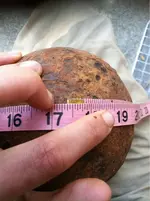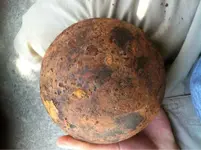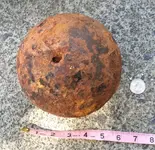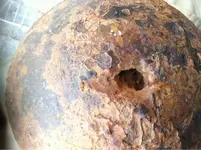Mangum wrote:
> This weighs about 60 lbs (although filled with dirt or something). It is roughly 17.25" in diameter.
Mangum, wrapping a measuring tape around a ball tells it circumference, not its diameter. But you can calculate the diameter by dividing the circumference by Pi (3.1416) -- which in your ball's case equals diameter of approximately 5.50-inches. That seems to more-or-less match up with what we see in your photo of the ball with the measuring tape under it.
But, you are measuring the ball with the tape on top of the rust encrustation, which makes the ball bigger than its "clean" iron surface would measure. You'll need to remove enough of the rust-crust to get an accurate size-measurement.
The 1861 US Ordnance Manual's "Shot Tables" charts at
www.civilwarartillery.com/shottables.htm
say a 5.68"-diameter solid iron ball weighs 24.3 pounds. You say your uncleaned 5.50"-diameter ball (which will be a smaller measurement after cleaning) weighs 60 pounds. That is 150% more than it should weigh, and is impossible unless the ball is made of solid Uranium or solid gold. Those metals are about 150% heavier than iron. Lead is about 60% heavier than iron.
About.com: http://www.reade.com/Particle_Briefings/spec_gra.html
So, please weigh that ball on a precision Postal Shipping scale (which tells the weight in pounds and ounces and fractions-of-an-ounce), and report the result. That will also tell us whether the ball is solid, or is hollow-bodied and has a rust-&-dirt-clogged fuzehole.)
The only cannonball which is even "near" the same diameter as yours is a Colonial-era French 16-pounder.







